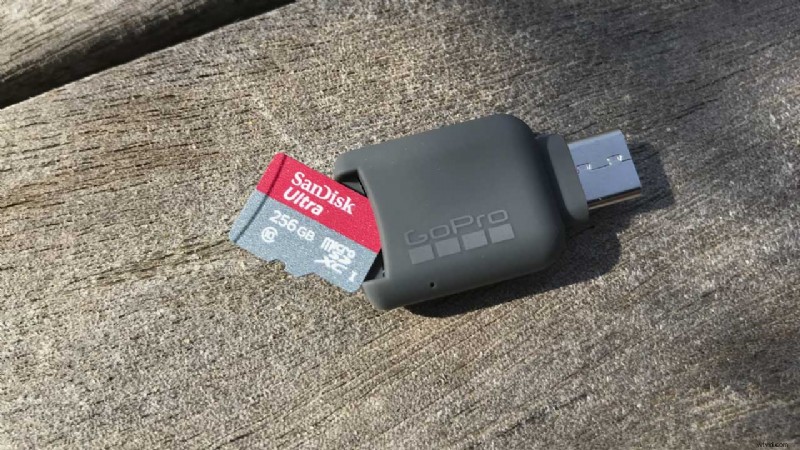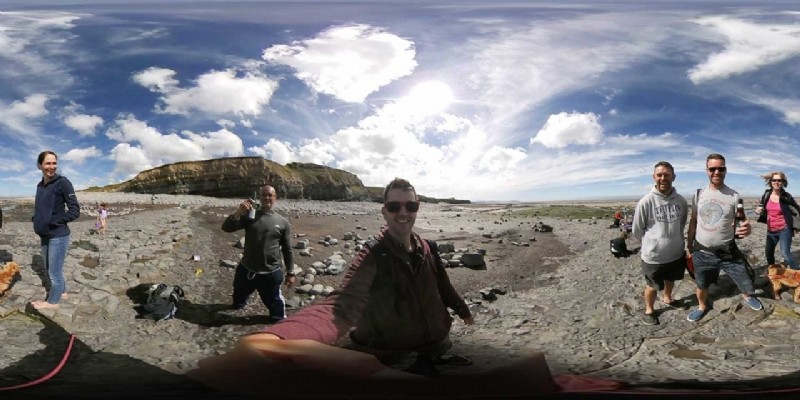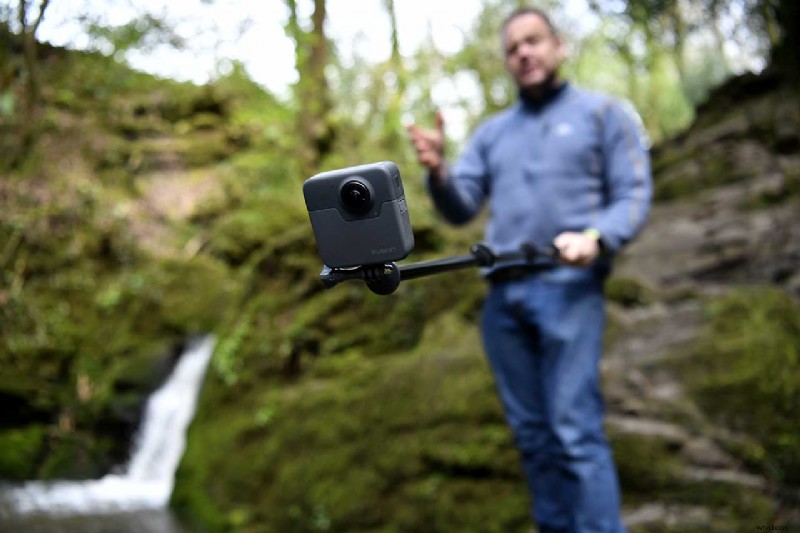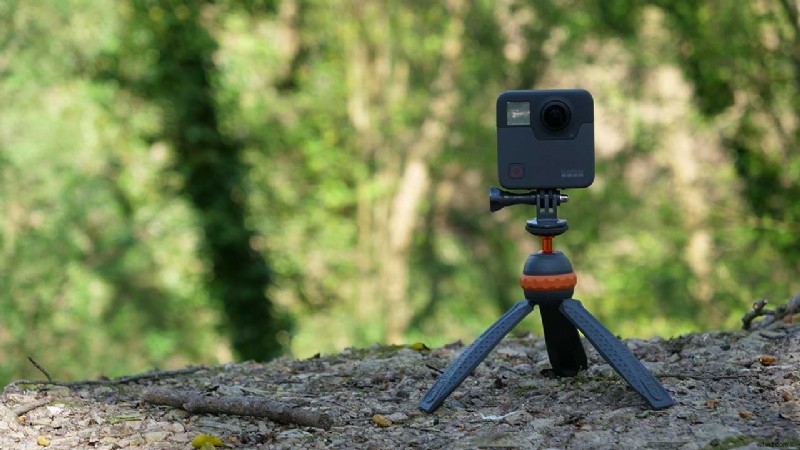La tecnología emergente en las cámaras 360 ha permitido a los fotógrafos capturar escenas como nunca antes. Pero usar esta tecnología 360 en todo su potencial requiere pensar en la composición, la exposición y algunos de los otros fundamentos de la fotografía y la videografía, de maneras completamente diferentes. Hay una buena cantidad de prueba y error involucrada en la creación de fotos y videos de 360°, pero esperamos que estos consejos y trucos de cámara de 360° que hemos obtenido de nuestra experiencia probando la tecnología más reciente lo ayuden a comenzar a crear contenido esférico del que pueda estar orgulloso.
¿Tienes algunos consejos geniales sobre la cámara 360? ¡Envíenos una línea y lo agregaremos a la lista con un crédito!
01 ¿Tu escena merece un tratamiento de 360°?
Una cosa que te enseñan sobre la filmación de videos es que te preguntes:¿esto justifica un video? Lo mismo puede decirse de las imágenes fijas y los videos en 360°. ¿Tu escena merece ser grabada? ¿Hay interés en ambos lados de la cámara? ¿Tu escena ofrece algo más allá del punto de vista predeterminado?
- Las mejores cámaras 360 de 2018

02 Usa una tarjeta microSD rápida
Lo que debe saber acerca de las tarjetas de memoria es que las velocidades de lectura/escritura afectarán en gran medida los tiempos de procesamiento. La mayoría de las cámaras 360 ahora graban video 4K, por lo que necesita una tarjeta de memoria que pueda satisfacer las demandas de esta resolución.
Cuanto más rápido una tarjeta de memoria pueda escribir datos, más rápidos serán sus tiempos de procesamiento. ¿Por qué? Bueno, elimine los números y la nomenclatura y piénselo en principio:su tarjeta de memoria está limitada a una cierta velocidad de lectura y escritura, y su metraje está bloqueado a estas velocidades para siempre.
Puede colocar esa tarjeta en una computadora de alta especificación y un software de edición de primera línea, pero no pueden compensar las velocidades más lentas a las que se escribieron los datos si optó por la tarjeta de memoria barata, pero lenta, en un Oferta relámpago de Amazon.
- Seleccionar la tarjeta de memoria adecuada para tu GoPro
¿Pero cómo sabes qué tan rápida es una tarjeta MicroSD?
La velocidad de escritura más importante de una tarjeta se muestra mediante la clase de velocidad, la clase de velocidad se relaciona con la velocidad de escritura secuencial mínima. Hay tres clases de velocidad que han ido avanzando con el paso del tiempo.
Originalmente había Speed Class 2, 4, 6 y 10. Estas clases dictaban que las velocidades mínimas de escritura eran 2, 4, 6 y 10 mb/s. A medida que aumentaron las demandas de velocidades de escritura, se lanzó UHS Speed Class con U1 y U3, nuevamente con velocidades de escritura mínimas de 10 mb/s y 30 mb/s.
Más recientemente, las tarjetas V Video Class han comenzado a aparecer con V6, V10, V30, V60 y V90 a velocidades de escritura mínimas de 6, 10, 30, 60 y 90 MB/s.
La Clase 2 es la más lenta y está bastante obsoleta, V90 es la versión más rápida y más reciente, por lo que es difícil de encontrar e increíblemente costosa. No se preocupe, una Clase 10 o cualquier otra superior es ideal para grabar videos 4K 360.
Antes de dejar las tarjetas MicroSD, también vale la pena señalar que no todas las cámaras pueden leer las capacidades de todas las tarjetas. Por lo tanto, si bien su cámara 360 puede leer la tarjeta V90 más reciente, es posible que no pueda reconocer una tarjeta de 1 TB.
Cada cámara 360 resaltará el rango de capacidad que reconoce en algún lugar de la lista de especificaciones; tome el Garmin Virb 360, que acepta una capacidad máxima de tarjeta de 128 GB.
Y 128 GB es lo que recomendaría en términos de capacidad, si tu presupuesto te lo permite. Esto le dará un poco de flexibilidad de almacenamiento para que no tenga que eliminar constantemente archivos de su tarjeta antes de poder editarlos.
- Qué son las clasificaciones de clase de tarjeta de memoria:Lexar responde a las preguntas de los fotógrafos

03 Pon tu sujeto frente a la lente principal
Hay mucho que ver en una escena 360 y, a menos que esté filmando una batalla espacial o algo igualmente extraño e intenso, es poco probable que cada esquina, rincón y grieta de su escena contenga un gran interés visual.
Entonces, debido a que todo gran video debe entretener, piense en captar la atención de su espectador desde el principio. La mayoría de las cámaras 360 y el software complementario le permiten ajustar el punto de vista de un archivo de video. Centrarse en la acción o el interés emocional encierra a alguien de inmediato.
Si observa los datos del mapa de calor de los videos 360, verá que las personas no suelen deslizar completamente una escena esférica. Deslizarán el dedo hasta que encuentren lo más interesante y se quedarán ahí, luego tal vez girarán un poco para ver qué más está pasando.
Encuentra algo interesante en tu metraje y cambia tu punto de vista para colocarlo al frente y al centro. Tus videos 360 obtendrán más vistas y tiempos de reproducción más largos.
- GoPro Fusion vs Garmin VIRB 360:which 360 camera should you choose?
Framing your POV
I use ‘frame’ for the lack of a better word. In a 360-degree scene we’re not really framing in the old sense. The best 360 photos and videos are those that have a lot going on. And like a good header image for a blog post, you want to think about that initial point-of-view shot in the thumbnail that lures people in.
If you’re at a landmark or recognisable location, make sure that’s in the frame of the lead lens. Or if there is action going on, make sure that’s the first thing people see.
Sometimes it’s difficult to know which lens is the ‘lead’ lens. You can usually tell quickly by opening the app and looking at the live preview.
If your 360 camera’s app doesn’t have live preview, or if you’re not using it with the app for whatever reason, what I tend to do is shoot the video with the camera turned one way. Then I turn it around 180 degrees and shoot the same video again, switching the lenses. One of those will be correct.
You can often switch the POV in your editing software, as well.

04 Embrace the selfie stick
There was a point in time just a few years ago when the selfie stick represented vanity and everything that depressed us about pop culture. But over time the selfie stick, like the touchscreen LCD and even video itself, has proved its worth and become a respectable photographic tool.
For 360 photographers and videographers, the selfie stick is even more than that. It’s an essential camera bag stalwart that enables you to record from unusual angles and make more dynamic spherical footage.
Good selfie sticks, such as the Manfrotto Aluminium Extension included in its PIXI EVO VR kit, can extend quite high and give pseudo aerial views that immediately make a spherical still or video more dramatic.
Selfie sticks can also be used as the antithesis of their name:to keep you out of a shot. I’ll explain more about this in the next tip, but let’s just accept the fact that you, we, all of us together, we’re not interesting. Not usually, at least. And certainly not when we’re shooting 360 videos amid a stunning landscape or striking architectural wonder.
05 Stay away from the camera
Nothing spoils a 360 video or image like the sight of you, huddled over your phone pressing the shutter control, distracting from an otherwise interesting view.
It’s not entirely your fault. Or my fault. Our fault. We’re working with nascent technology, and the WiFi range of some 360 cameras is a bit limited, meaning you can’t get too far away and still be able to control them remotely.
To remove myself from the footage, what I tend to do is find something I can hide behind. A cabinet, or even inside a car, for instance. I’ve even crouched under a fallen tree and covered myself with brush. The things we do, eh.
But the key is really knowing where and when you belong in a scene. In a pristine landscape where you’re capturing waterfalls and endless bluebells and birdsong on your spatial audio, the sight of you jabbing at your phone is going to spoil the mood. So hide behind that tree trunk.
If you’re shooting a busy city scene, though, the sight of you there stationary amid the throngs of commuters could make for a nice juxtaposition.
- How to set up your GoPro Fusion
06 Be selective with your shots
In some ways shooting 360 stills and video has reminded me of the old days of shooting film. For a couple different reasons. For starters, some cameras are launched before their companion apps are fully developed, and this means that sometimes you’re shooting without the aid of live preview on your phone. This was the case with the Vuze camera, which I recently re-tested with its updated app.
Shooting blind means going on gut instinct and past experience, and in these instances I’ve founder fewer files is better until you establish a routine that you know works.
The main reason for selectivity with 360 video, though, is file size and processing time. My go-to 360 camera is the GoPro Fusion, which has fabulous image quality, but its 5.2K video files take up a lot of space on your microSD cards. They also can take an age to render.
Because of the size requirements and processing times, being more selective with your shots means that you’re spending time and space only on those clips that are important to you.
Being selective will also make your battery last longer.
- iPhone video tips:how to focus and improve exposure
- How to get started with iPhone video
07 Do you need 5.7K? Do you need 4K? Is Full HD enough?
With this selectivity in mind, ask yourself… do you really need to shoot in 5.7K or 5.2K? For that matter, do you even need to shoot in 4K?
Personally, I often shoot in Full HD. For my personal stuff, HD quality is good enough for sharing with friends and family. And it renders in a fraction of the time. And I can store it a whole lot easier.
Also think about your scene here when choosing your resolution. Are there a lot of fine details that you want to broadcast in crisp clarity? Well 4K or higher might be worth the extra investment of time and space.
If your scene is more about ambience or remembering a shared experience than fine details, shoot Full HD and you’ll have more time to share experiences!
- How to shoot a 360 timelapse video with the GoPro Fusion
08 Even light is your friend
360 camera technology is still improving, but one of its Achilles Heels is purple fringing in high-contrast scenes. If you can avoid them, do!
Many 360 cameras also have trouble capturing detail in heavy shadow areas because they don’t have the dynamic range that cameras with bigger sensors have.
Scenes that offer the best exposures are those with flat, even lighting. Depending on your subject, look for an overcast day to film that clip you’ve been wanting to capture.

09 You need a mini tripod
A lot of 360 cameras either don’t stand up on their own (the Fusion) or can do so but are susceptible to a slight breeze (the Ricoh Theta V).
A mini tripod not only keeps your 360 camera stable, but it opens up a world of creativity. I’ve stuck mine on the edge of a waterfall, the dash of a car with Blu-Tac on the feet, the roof of a chicken coop and other odd places. I also use mine as a grip and selfie stick.
Manfrotto’s PIXI range is very good, and GoPro provides a really nice tripod/grip with the Fusion, but my favourite mini tripod these days is the 3 Legged Thing Iggy, which comes with the standard screw mount and a GoPro mount, meaning I can use it for all my 360 cameras. I have too many 360 cameras.
10 Where to share your 360 photos and videos
One of the downsides of shooting 360 video and photos is that the web really hasn’t fully caught up with the functionality. Until recently you could shoot these amazing images and videos, but you could only post them on manufacturer’s dedicated sharing platforms, which none of your friends and family are one.
It’s gotten a bit better. Google Photos now supports 360 functionality. So does Facebook. And YouTube will play your videos in all their 360 glory provided they have some crucial metadata added to the file. Your camera’s 360 editing software typically does this during a render. Otherwise, Google has a free tool you can use to do the same job.
If you want to display your 360 images on your blog, I find that Kuula is a great resource. Simply create a free account and upload your 360 photo, then copy the shortcode and place it in your blog text. Job done. It’s what I use for my 360 camera reviews on this website.
- GoPro Hero 6 Black vs GoPro Hero 5 Black
- GoPro Hero6 Black vs Yi 4K+:which is the best action camera?
- GoPro Hero6 Black vs Garmin Virb Ultra 30:which is the best action camera?
